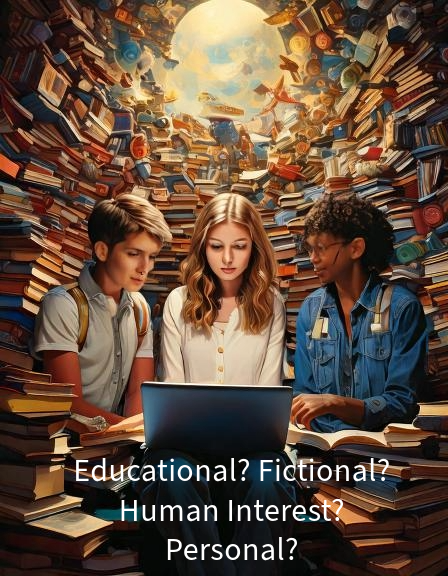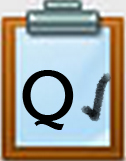Q1 Process: Types of Stories
Now that you have explored the elements of a digital story, you will choose the type of story you will create.
Follow the steps on this page and keep these three things in mind:
- Stories are powerful tools for communication.
- Different types of stories serve different purposes.
- Your choice of story type depends on what you want to express.
Step 1. Check with your teacher about working with a partner or individually.
- Expand the content boxes below.
- Read each of the descriptions of a story type and explore the short story videos for each type.
Educational Narrative
An educational narrative is a story designed to teach or inform viewers about a specific topic or concept, often using visuals and interactive elements. It might be about something in science such as a hurricane or earthquake, the migration of the monarch butterfly, or a historical event that explores something in the past.
Here are examples of retelling historical events or people:
- Historical Gettysburg Digital Story Telling Video (2:32)
- Amerigo Vespucci Video (3:13)
Fictional Narrative
Fiction stories typically focus on relatable characters facing challenges, often with elements of adventure, mystery, sci-fi, or fantasy that maintain a sense of reality. It is a made-up tale, created from the author's imagination, that tells a sequence of events with characters, a setting, and a plot, where everything is not based on real life but is meant to entertain and engage the reader.
Some popular examples include:
- Harry Potter series by J.K. Rowling
- The Hobbit by J.R.R. Tolkien
- Chronicles of Narnia by C.S. Lewis
Here are two examples:
- A Day Without Math Digital Story Telling Video (3:00)
- Book Creator titled The Rat and the Old Man by Emma Pope.
Personal Narrative
A personal narrative tells the true story of something that happened to the author. Because personal narratives tell a true story from an author's life, they are rich with emotional content. A good writer puts the reader in the midst of the action so they can live through the events of the story as they are unfolding.
Here are two examples:
- Chasing After the Hummingbird WeVideo (2:11 mins)
- The Day the Rain Stopped Video 2:32
Step 2. When done, talk with one or more classmates and discuss the following:
- Which stories did you like the best and why?
- As you think about the stories you explored, which type of story would you like to create? Do you want to share a personal experience or create a fictional world?
- What message or lesson do you want to tell in a story?
- Is there an emotion you want your audience to feel?
Step 3. Decide which type of story you will create and communicate that to your teacher.

Competencies & Standards
MITECS Michigan Integrated Technology Competencies for Students, and
3. Knowledge Constructor
c. Curate information from digital resources using a variety of tools and methods to create collections of artifacts or solving authentic problems
4. Innovative Designer
a. Know and use a deliberate design process for generating ideas, testing theories, creating innovative artifacts or solving authentic problems
6. Creative Communicator
a. Choose the appropriate platforms and tools for meeting the desired objectives of their creation or communication
b. Create original works or responsibly repurpose or remix digital resources into new creations
d. Publish or present content that customizes the message and medium for their intended audiences
Websites and Documents
Websites
- The Rat and the Old Man by Emma Pope (Created in Book Creator)
Videos from Outside Sources
- 7 Elements in 4 Minutes YouTube (4:00)
- A Day Without Math Video (3:06)
- Amerigo Vespucci Video (3:13)
- Chasing After the Hummingbird WeVideo (2:11)
- Gettysburg Video (2:32)
- "Lion and the Woodcutter" and the Art of Storytelling YouTube (1:45)
- The Day the Rain Stopped Video (2:32)
21t4s Documents & Quizzes




